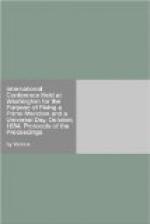No. 3 is a letter from M. de Chancourtois, accompanying a work by him which contains an elaborate program of a system of geography based on decimal measures, both of time and of angles, and on the adoption of an international meridian.
The work also contains
copious historical notices on the
metric system and on
the initial meridian.
A copy of this work was presented to each of the Delegates prior to the discussions of the Conference with regard to the choice of an initial meridian, and therefore no special report of the author’s views on this subject appears to your committee to be necessary. These views are nearly identical with those which were so ably laid before the Conference by Professor Janssen, but which failed to meet with their approval.
The author further proposes to supersede the present mode of measuring both angles and time by a system in which the entire circumference and the length of the day should each be first divided into four equal parts, and then each of these parts should be subdivided decimally.
However deserving of consideration these proposals may be, in the abstract, your Committee are clearly of the opinion that they do not fall within the limits indicated by the instructions which we have received from our respective governments, and that, therefore, any discussion of them would only be of a purely academical character, and could lead to no practical result. Such a discussion would be sure to elicit great differences of opinion, and would, therefore, occupy a considerable time.
Hence, your Committee
think that it would be very
undesirable for the
Conference to enter upon it.
No. 4 is a letter from Mr. Spofford, Librarian of Congress, including a communication of Mr. J. W. Stolting, Dobbs’ Ferry, N. Y. The author recommends the adoption of the meridian 162 deg. W. from Greenwich as the prime meridian; he proposes further, not to say east or west, but first or second half, and also recommends the adoption of a universal time, not to interfere with local or other standard time, and to reckon from “1 to 24.” He expresses no opinion as to whether the day should begin at noon or midnight. There seems to be nothing in the communication to influence the decisions of the Conference.
No. 5. See report as to letter No. 1.
No. 6 suggests that the prime meridian should be 180 deg. from Greenwich, and that longitude should be reckoned from 0 deg. to 360 deg.. This proposition has been already considered and rejected by the Conference.
No. 7. This communication proposes “to adopt as the prime meridian the frontier line between Russia and the United States, as defined in the treaty of March 30, 1867.” As the initial meridian has already been agreed to by the Conference, this proposition needs




